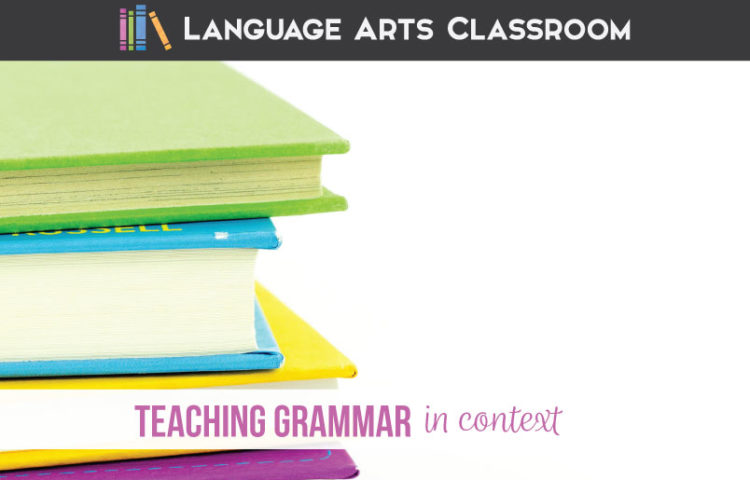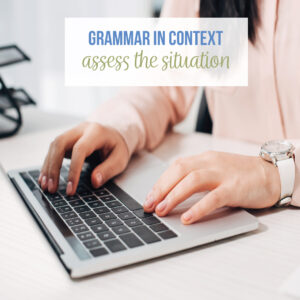Teaching grammar in context? Teaching grammar in context activities? ELA teachers can accomplish this task.
You’re teaching grammar as more than as a bandage to writing, more than circling nouns on a worksheet. If you’re automatically seeing success, I am so happy for you! (That was not my experience, if I am being totally honest.)
For others, you might cry over grammar instruction. You might wonder why you started this process and if you should continue. Someone maybe told you to teach grammar—a friend, a blogger, an administrator. You are teaching grammar in context for the first time, and success is not what you’re seeing. Other ELA teachers might tell you: Teach grammar in context! (What does that mean?)
I’ve been there. Teaching grammar successfully rarely happens automatically. Effectively teaching grammar, connecting it to students lives, and aligning it with standards takes hard work and purposeful planning.
I want you to achieve success with your grammar lessons, and I know you want to meet those tough standards with your students. In this post, I’ll walk you through the lessons I’ve learned as an English teacher who has both failed and succeeded with grammar lessons. No matter the grade of your grammarians, these ideas will work for multiple ages with a few modifications.
First, you might ask what is teaching grammar in context? To me, grammar in context is simply recognizing, identifying, and purposefully implementing grammatical ideas outside of “grammar lessons.”
Second, you probably wonder how to teach grammar in context. Don’t worry; once you see how to connect grammar lessons to other parts of class, you’ll never stop incorporating grammar and language every day!
Teaching grammar in context can be achieved. Here is my process.
Assess the situation
If you have a class and you are not sure of their understanding of grammar, give a pretest. Frame the pretest as understanding your students as learners. . . which is true. Students appreciate not repeating information they’ve learned and understand. If a class identifies phrases and clauses, perfect. Let’s move to using sentence structure as transitional tools in writing. You might not experience that, however.
On the flip side, students might not know basic concepts. If you have numerous feeder schools into the high school, you could have groups of students with varying levels of knowledge. Schools teach different topics, and you simply won’t know what grammar your students understand. Before you begin advanced concepts and ask students to critique grammar in literature or apply concepts to writing, students should know basic concepts. A pretest will give you guidance, and you can then plan your grammar lessons from the data.
Strong knowledge
If most students are familiar with parts of speech, an overview (a few days!) will probably work. You might be able to quickly review conjunctions and pronouns, but specify the specific types of pronouns (especially relative pronouns for dependent clauses) and conjunctions. Think of what your next step in meeting standards will be. For instance, most seventh grade standards ask students to choose different sentence structures. Chunk review of clauses and punctuation and then move to simple, compound, complex, and compound-complex sentences.
Medium knowledge
Sometimes, the data from the pretest will show you that students are aware of grammar, but they have not really applied or analyzed the concepts. (Actually, I find this is where most students are in their grammar knowledge.) Provide a dash of direct instruction where students’ understanding is muddy, and then move to application. For instance, if students understand that a clause has a subject and a verb but they cannot distinguish between a dependent and an independent clause, you might review those definitions.
Next, you could apply those ideas to sentence structure lessons. Capitalize on students’ prior knowledge and advance them to the next step.
Low knowledge
The pretest will also show where you should start if students are unfamiliar with basic grammar concepts. Do most students need to review verbs? modifiers? The pretest will help you plan future grammar lessons.
Students deserve to know the definitions and basic lists. After giving students tools, ask them to implement those concepts in another area. For instance, when I teach adjectives, we immediately write about candy. With a high-energy activity, students remember adjectives, and then I can move to more difficult concepts like coordinate adjectives.
Plus, the pretest builds a relationship with you and students. Some students experience poor grammar instruction and relate grammar to problems with their writing. You are instead putting forth the idea that you will study language with your students in an exciting way. You care about your students so much that you want them to succeed and do not want them bored.
Finally, you can show students how they grew as the school year ends. Share data from the start of the year to the end of the year. You are fostering growth, not a poor attitude toward grammar instruction.
Start with direct instruction
Direct instruction seems to be out of style currently, and I agree that this should not be the only teaching method. However, with difficult concepts, direct instruction can clarify confusing ideas or definitions and provide concrete examples. Plus, some students dislike asking for help if they think their classmates understand the lesson. They don’t want to be the only one confused, so they simply don’t ask. Direct instruction allows clarification.
Next, if you are teaching grammar for the first time, it might be helpful to look at someone else’s lesson plans. I’ve turned mine into presentations so you can watch and borrow from them. When I began teaching grammar successfully, I began researching best methods and asking for feedback. I learned that starting with direct instruction and then moving to application would work with grammar lessons, just like other parts of my curriculum.
Don’t hover in direct instruction for too long. Students will become bored and reluctant to experiment. Part of learning is experimenting and making mistakes.
Try varying activities
First, finding activities that your class enjoys can change grammar instruction. Don’t worry about a complete overhaul of your grammar curriculum immediately. Start slowly and add materials with the rest of your material. Next, continue to try different methods.
I’ve written numerous times about grammar activities that are not grammar worksheets. You can check out those posts for specific ideas, but my favorite grammar activities that encourage collaboration, creative thinking, and innovation are:
Graphic organizers
Graphic organizers naturally scaffold themselves, so using graphic organizers with grammar lessons is a given. Ask students to find a concept from another source (my favorite source = picture books), and fill the graphic organizer. Then, create a new product using the grammar concept in application.
Stations
Some classes learn best from stations. As a teacher, I gain great insight into students’ struggles and successes. Brain-based learning tells teachers that brains work better together. When I see students problem-solve and ask each other questions, I sense what direction my future lessons should go.
One pagers
A one-pager allows students to show what they know in unique ways. Typically, grammar one pagers normally become vocabulary activities and part of word walls.
Grammar sorts
A grammar sort allows students to specify the differences between concepts. Students “sort” the concepts and then draw conclusions.
Like any other component on an English class, experiment with the best way that students learn. As you work through grammar activities, ask students for feedback. Students will gladly share what they like and dislike.
Connect grammar to the rest of class
I stress to my students the concept that all of a language arts class fit together. Explaining that is a cornerstone of my instruction.
For instance, I never want my students to think that ethos, pathos, and logos are only concepts applied to speeches. I never want them to think that the literary devices only exist in literature. I want students curious to learn new words, to manipulate those words into different forms. Similarly, I want students to recognize grammatical concepts in the rest of class.
Start small: Simply notice a few nouns in the story you are reading. Branch out into different pronouns. Before your eyes, students will analyze active and passive voice and types of sentences. Some students really enjoy grammar.
You can then expand. Pull sentences from a speech and ask students to critique it. How did the speaker use parallelism to highlight her points? What verbs proved the speaker’s points? Did conjunctions provide transitions?
Teach grammar in context
As you work through direct instruction, try varying activities, and connect grammar to other parts of the class, you might realize one day that you are indeed teaching grammar in context. Perhaps you went off-script and noted an interesting use of punctuation. You maybe applauded a student because his sentence structure provided extra organization.
Whatever “context” you were teaching in class, you connected it to grammar. Congratulations! You’ve done it.
For inspiration, look at this quote from Erin Harrity:
Immersing students in authentic reading and writing activities, using mini-lessons to teach grammatical concepts, and showing applied grammatical concepts in real life leads to better student writing. Teachers must also focus on the individual writing needs of their students and stop seeing grammar instruction as a hunt for errors.
Grammar lessons can make sense to students when we teach the concepts in context, and research supports your efforts. Most often, teachers connect grammar to writing which is fabulous. The mistake (which Harrit’s research supports) is when “grammar lessons” become “recognize these grammar mistakes.” Students will balk at grammar instruction if that instruction always means finding what they did wrong in an essay.
Grammar, the understanding of language, is more than mistakes in writing. To truly teach grammar in context, students should see how writers (including themselves) experiment with language.
Stop and reflect
Teaching grammar for the first time. . . my experience was disastrous. I taught “grammar” as a unit and never considered teaching grammar in context. The kids hated it, and I dreaded teaching it. I didn’t connect grammar to speeches, literature, or writing. I didn’t differentiate. Worksheets were the norm. I almost quit teaching grammar for the year.
Taking a break
Instead, I took a break. I reflected and decided that grammar must contain more. I collaborated with coworkers who told me that a “grammar unit” would never work. For students to understand grammar, I needed to redo my grammar instruction. (I’m so thankful they were honest.) I’m sharing this story because I don’t want other teachers to quit teaching grammar after one bad experience like I almost did.
If you’ve gone through the process outlined above and you have not experienced success, take a moment to reflect.
Reflect and collaborate
Years ago, I knew my grammar lessons had to look different, but I had not figured out my groove. Slowly, I pulled sentences from literature that we were studying, analyzed them, and made them into activities. All of this happened slowly. For years, I largely depended on the grammar worksheet, but my goal was always to move students toward analytical thinking concerning grammar. I began by rooting instruction with the grammar worksheet and then asking students to write with the new concept. Then, I gained confidence and started with students’ prior knowledge and built new lessons from there. After years of experience, the majority of my grammar lessons do not involve a grammar worksheet.
It became my passion to make grammar “more” and to help other teachers teaching grammar for the first time, primarily because I saw the success at teaching grammar in context. If you’d like to try some of my methods for elevating grammar lessons, you can download this activity sheet for free.
 But before I experienced success, I stopped for a bit. The key was that I reflected on my grammar lessons. I reflected on what did not work, and I gave it a rest. That might be what you need. Think of a different approach and return to grammar later. Pause and reflect.
But before I experienced success, I stopped for a bit. The key was that I reflected on my grammar lessons. I reflected on what did not work, and I gave it a rest. That might be what you need. Think of a different approach and return to grammar later. Pause and reflect.
Teaching a new concept won’t be perfect, but with tweaks and experimentation, you can succeed.
What is teaching grammar in context? Grammar in context involves moving grammar lessons beyond the first ten minutes of class. Bring in vocabulary, writing, and literature to grammar lessons, and watch student understanding grow.

As always, there is more than one way to teach ELA. If you’re looking for an alternate perspective, Melissa at Reading and Writing Haven is sharing how she decides when it’s time to move on with grammar.








